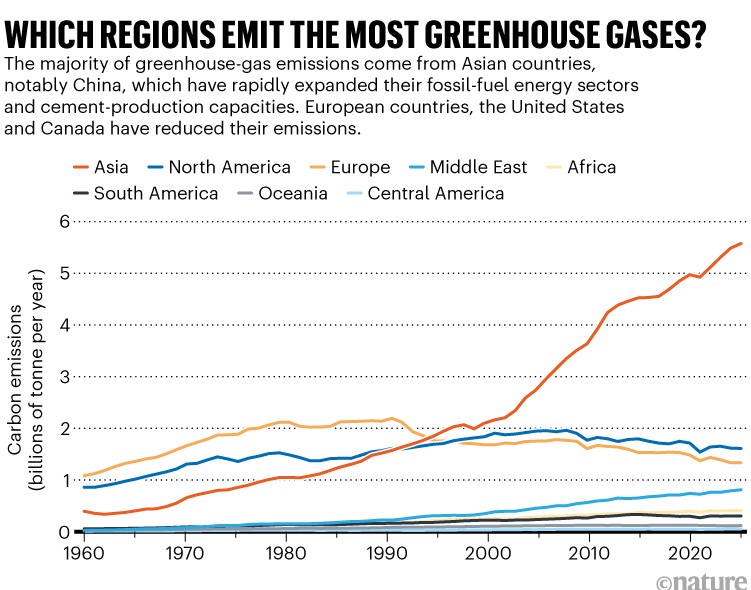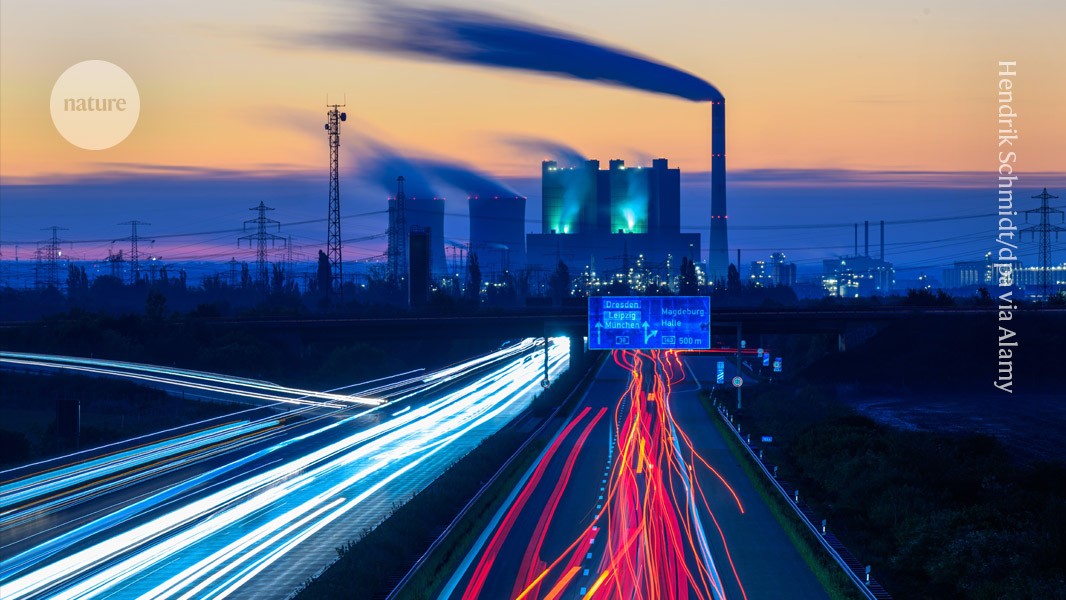
Carbon emissions are continuing to increase each year and are projected to rise by 1.1% by the end of 2025.Credit: Hendrik Schmidt/dpa via Alamy
Global fossil-fuel emissions are likely to hit yet another record high this year, scientists announced today at the COP30 UN climate summit in Belém, Brazil, but there are signs that the world is approaching a peak. Indeed, some researchers argue that carbon dioxide emissions might have already begun to decline, and many think that overall greenhouse-gas emissions (including methane, nitrous oxide and fluorinated gases) could begin to decline by the end of the decade.
Emissions from the burning of fossil fuels and cement production are projected to rise by 1.1%, to 38.1 billion tonnes of CO2 this year, according to data published on 13 November by the Global Carbon Project, an international consortium of researchers who track carbon emissions.
Overall carbon emissions could decline slightly if a projected drop in deforestation and other land-use changes is factored in, but researchers warn that it’s still too early to say that the world has turned a corner on its fossil-fuel addiction (see When will carbon emissions peak?).
“We don’t [project] the global inflection point until around 2030, unfortunately, but it does look like emissions are flattening off,” says Bill Hare, a physicist who is head of Climate Analytics, a non-profit consultancy in Berlin that analyses the impact of global climate policies.

The China factor
As it stands, greenhouse-gas emissions are around 10% higher than a decade ago, when the Paris climate agreement was signed, and a far cry from what is needed to limit warming to 1.5 °C above pre-industrial levels, as called for under the agreement.
Emissions among the major industrialized countries, which are responsible for the bulk of historical emissions, have been falling for more than two decades (see Which regions emit the most greenhouse gases?).
However, they are rising nearly everywhere else. Although much of the focus tends to fall on rapidly developing juggernauts such as India and China, the growth is widespread as low- and middle-income countries seek to grow their economies and fulfil energy demands.
By far the biggest driver over the past two decades has been China, which now accounts for nearly one-third of the world’s greenhouse-gas emissions. The main culprit is the country’s vast and still-growing fleet of coal-fired power plants, which burnt nearly 2.3 billion tonnes of coal last year, according to the International Energy Agency.
There are signs of change, however, with China now leading the global clean-energy sector. The country is rapidly turning to electric vehicles as well as wind and solar energy and has committed to reduce overall greenhouse-gas emissions by at least 7% from peak levels by 2035. When China’s emissions peak, so, too, will global emissions, predicts Hare.

Have China’s emissions already peaked?
Others argue that China’s carbon emissions have already begun to decline. Data from Carbon Monitor, a frequently updated data set that began tracking daily carbon emissions during the COVID-19 pandemic, suggest that China’s carbon emissions peaked in 2024 and will fall by 1.2% this year. Researchers at the Centre for Research on Energy and Clean Air (CREA), a think tank based in Helsinki, have also documented a downward trend.
Although the expansion of electric vehicles and renewable energy is having an impact, the biggest factor in the current decline is the collapse of the Chinese real-estate market, which has resulted in less demand for cement and steel, says Zhu Liu, an Earth-systems scientist at Tsinghua University in Beijing.
Earth shattered heat records in 2023 and 2024: is global warming speeding up?
Given current energy and economic trends, as well as China’s climate goals, Liu says, emissions of CO2, at least, are likely to continue to decline. “I would say this is the peak of China’s carbon emissions,” Liu says.
If that’s the case, the question is whether emissions of other greenhouse gases, will follow.



